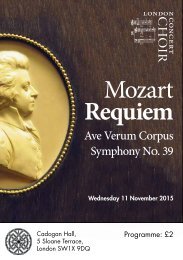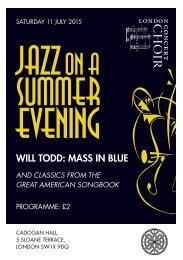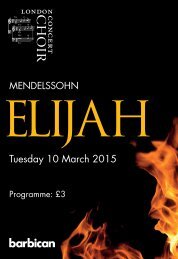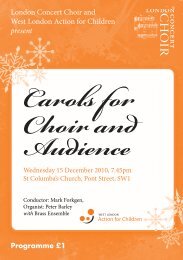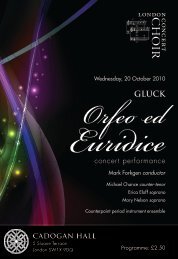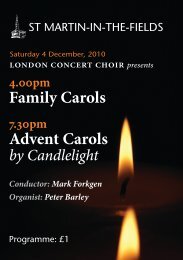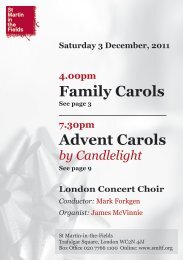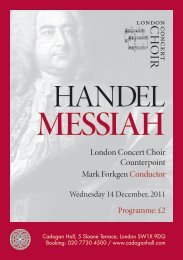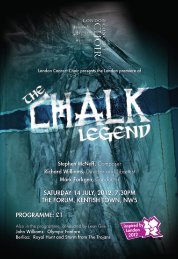27 September 2011: War & Peace - Mass in Time of War (Haydn) / Dona Nobis Pacem (Vaughan Williams)
Create successful ePaper yourself
Turn your PDF publications into a flip-book with our unique Google optimized e-Paper software.
RALPH VAUGHAN WILLIAMS (1872-1958)<br />
<strong>Dona</strong> <strong>Nobis</strong> <strong>Pacem</strong>:<br />
Cantata for soprano & baritone soloists,<br />
chorus & orchestra<br />
1. Agnus Dei: Lento<br />
2. Beat! Beat! Drums: Allegro moderato<br />
3. Reconciliation: Andant<strong>in</strong>o<br />
4. Dirge for Two Veterans: Moderato alla marcia<br />
5. The Angel <strong>of</strong> Death has been abroad: L’istesso tempo<br />
6. O man greatly beloved<br />
The dist<strong>in</strong>ctive verse <strong>of</strong> Walt Whitman, notable for its powerful use <strong>of</strong> language and<br />
equally potent alliterative rhythms, proved to be an <strong>in</strong>spiration to <strong>Vaughan</strong> <strong>Williams</strong><br />
throughout the composer’s life. He wrote his cantata <strong>Dona</strong> nobis pacem <strong>in</strong> 1936,<br />
and <strong>in</strong> what proved to be an anticipation <strong>of</strong> Benjam<strong>in</strong> Britten’s <strong>War</strong> Requiem<br />
(1960), he opted to mix the potent poetry <strong>of</strong> war with texts from the Lat<strong>in</strong> <strong>Mass</strong>,<br />
along with other extracts beyond.<br />
The po<strong>in</strong>ts <strong>of</strong> reference are at once bold and orig<strong>in</strong>al: three contrast<strong>in</strong>g poems by<br />
Whitman are framed by words taken from the Lat<strong>in</strong> <strong>Mass</strong>, the Old Testament prophets,<br />
and the famous House <strong>of</strong> Commons speech that John Bright made at the time <strong>of</strong> the<br />
Crimean <strong>War</strong>.<br />
An important musical <strong>in</strong>fluence for <strong>Vaughan</strong> <strong>Williams</strong> was Verdi’s Requiem, a work<br />
he admired very much. For the music <strong>of</strong> Verdi’s Kyrie movement is echoed at several<br />
po<strong>in</strong>ts <strong>in</strong> the open<strong>in</strong>g section <strong>of</strong> <strong>Dona</strong> nobis pacem. The l<strong>in</strong>k can be made, for example,<br />
<strong>in</strong> the sett<strong>in</strong>g <strong>of</strong> the word ‘<strong>Dona</strong>’. Similar parallels can be found <strong>in</strong> the treatment <strong>of</strong><br />
Beat! Beat! Drums!, which <strong>Vaughan</strong> <strong>Williams</strong> employs as an equivalent to the<br />
convention <strong>of</strong> the Dies Irae. At this po<strong>in</strong>t he makes full and effective use both <strong>of</strong> the<br />
jagged alliterative potential <strong>of</strong> the text, and <strong>of</strong> the powerful percussion battery among<br />
the large orchestra. Thus he creates with the utmost immediacy the <strong>in</strong>tense noise and<br />
pervasive disruption <strong>of</strong> warfare.<br />
That <strong>Vaughan</strong> <strong>Williams</strong> should feel able to depict such sonic <strong>in</strong>tensity with conviction<br />
is no surprise. It is conceivable that the artillery barrages <strong>of</strong> the Western Front<br />
returned to haunt him via the medium <strong>of</strong> Whitman’s beat<strong>in</strong>g drums.




